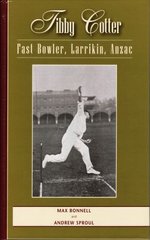Tibby Cotter
Archie Mac |Published: 2012
Pages: 142
Author: Bonnell, Max and Sproul, Andrew
Publisher: Walla Walla Press
Rating: 4.5 stars

The sub heading to this book is Fast Bowler, Larrikin, Anzac. This sums up everything that makes up the legend which is fast bowler Andrew “Tibby” Cotter.
The sub heading verbs resonate as much now with me as a 47 year old as they did when I was a teenager and read about Cotter for the first time. I was fascinated by a book written by cricket historian Jack Pollard which told the story of “Tibby” Cotter, and how he had been shot and killed by a sniper in the Great War, after he had lifted his head out of a trench to confirm what his periscope had shown him.
Inspired, I travelled to the Australian War Memorial (AWM) and scoured the list of names of those who had fallen in the Great War. It took me a while but I finally found A. Cotter on the huge plaques that surround the remembrance fountain at AWM and that was it, I had found him and in my find confirmed a hero’s death. There had been other stories regarding Cotter’s death that I had read over the years but the first I read in the Pollard book remained the ultimate story in summing up all that was romantic about Cotter.
Well it seems the Pollard story is just that, a story, as the authors of Tibby Cotter, demonstrate by dint of research and circumstantial evidence. The Pollard story I read was a retelling of one by David Frith, as told to him by Test cricketers and soldiers who served with Cotter, including Bert Oldfield, although there are other versions of Cotter’s death, all included in Tibby Cotter. This whole story of the fast bowlers death and evidence of an official cover up make this book an informative and intriguing read.
However the death of Cotter is not the only mystery dealt with in this publication. We also have evidence that the lifetime bachelor may have fathered a child with an English barmaid during one of his Ashes tours to England. This possible piece of romance and lost love adds a delightful human touch to the book and helps to flesh out the character of Cotter.
It was not that easy for the authors to put flesh on the Cotter legend. He left no memoirs, was not a letter writer and died a young man. The impression left of Cotter is one of a loyal friend. This loyalty often saw Cotter clash with officialdom as he supported his “mates”. One such clash with the Australian Cricket Board of Control cost him a place in the 1912 Australian team as he became one of the “Big Six” who refused to agree terms. Alas Cotter never played Test Cricket again. But despite his proclivity to battle authority Cotter comes across as an essentially simple man who loved life and was liked by just about everyone.
His simple character can be seen in his bowling. Cotter liked to bowl fast and does not appear to have been a thinking man’s fast bowler. His action and attitude seem to have been similar to that of a latter day fast bowler, Jeff Thomson, who once said “I just roll up and go whang”.
If you don’t know the legend that is Tibby Cotter, and also if you thought you did, you should not miss this quality book, by the end of which you will know he was a true Fast Bowler, a true larrikin and perhaps fittingly, a true Anzac.






Leave a comment